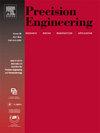Automatic precision matching method of optical measurement data for blade profile quality detection
IF 3.5
2区 工程技术
Q2 ENGINEERING, MANUFACTURING
Precision Engineering-Journal of the International Societies for Precision Engineering and Nanotechnology
Pub Date : 2025-03-01
DOI:10.1016/j.precisioneng.2025.03.004
引用次数: 0
Abstract
Blades are key components in aviation engines, determining energy conversion efficiency, operational safety, and lifespan. During the precision machining, assembly, and maintenance stages of damaged blades, three-dimensional measurements are necessary to accurately guide related process flows. To precisely measure various surface quality errors on blades, a measurement reference standard is usually introduced when aligning measurement data with CAD models. However, the complexity of thin-walled blades and significant noise interference makes it challenging to accurately locate optical measurement data. This paper proposes an automatic method for matching blade optical measurement data with CAD models, allowing for precise alignment of actual blade measurement data with their theoretical CAD models. To achieve this, the method prioritizes matching the tenon surface data based on structural features in the point cloud data. Firstly, a point feature descriptor is developed for the quick and automatic retrieval of tenon points from the blade point cloud. Secondly, a new sample consensus pose estimation technique is introduced. This method imposes constraints on the maximum distance from the normal vectors during the compatibility sorting process, facilitating the generation of more reasonable hypotheses. Through rigorous hypothesis verification, the optimal rotation and translation matrices are determined. Finally, experimental results on actual measurement data and simulated datasets demonstrate that the proposed matching method achieves high accuracy and efficiency.
叶片型面质量检测光学测量数据的自动精密匹配方法
叶片是航空发动机的关键部件,决定着能量转换效率、运行安全性和使用寿命。在损坏叶片的精密加工、装配和维修阶段,需要三维测量来准确指导相关的工艺流程。为了精确测量叶片的各种表面质量误差,通常在将测量数据与CAD模型对齐时引入测量参考标准。然而,薄壁叶片的复杂性和明显的噪声干扰给精确定位光学测量数据带来了挑战。本文提出了一种叶片光学测量数据与CAD模型自动匹配的方法,实现了叶片实际测量数据与理论CAD模型的精确对齐。为了实现这一点,该方法基于点云数据中的结构特征优先匹配榫面数据。首先,开发了一种点特征描述符,用于快速、自动地从叶片点云中提取榫卯点;其次,介绍了一种新的样本一致姿态估计技术。该方法对兼容性排序过程中与法向量的最大距离进行了约束,有利于生成更合理的假设。通过严格的假设验证,确定了最优的旋转和平移矩阵。最后,在实际测量数据和仿真数据集上的实验结果表明,本文提出的匹配方法具有较高的精度和效率。
本文章由计算机程序翻译,如有差异,请以英文原文为准。
求助全文
约1分钟内获得全文
求助全文
来源期刊
CiteScore
7.40
自引率
5.60%
发文量
177
审稿时长
46 days
期刊介绍:
Precision Engineering - Journal of the International Societies for Precision Engineering and Nanotechnology is devoted to the multidisciplinary study and practice of high accuracy engineering, metrology, and manufacturing. The journal takes an integrated approach to all subjects related to research, design, manufacture, performance validation, and application of high precision machines, instruments, and components, including fundamental and applied research and development in manufacturing processes, fabrication technology, and advanced measurement science. The scope includes precision-engineered systems and supporting metrology over the full range of length scales, from atom-based nanotechnology and advanced lithographic technology to large-scale systems, including optical and radio telescopes and macrometrology.

 求助内容:
求助内容: 应助结果提醒方式:
应助结果提醒方式:


